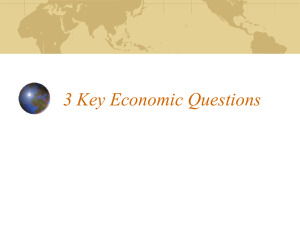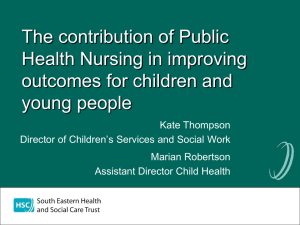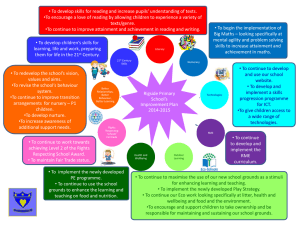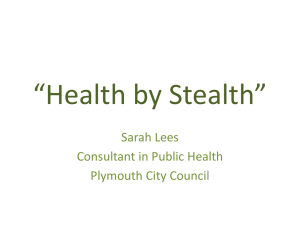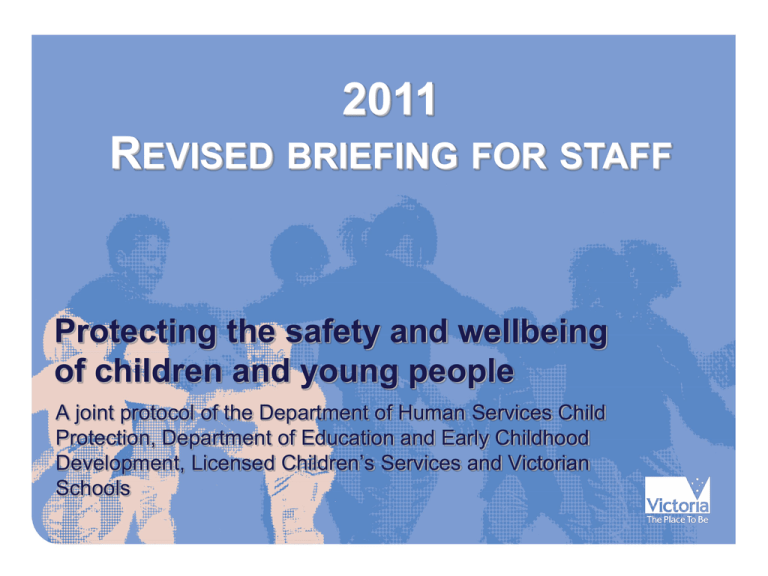
2011
REVISED BRIEFING FOR STAFF
Protecting the safety and wellbeing
of children and young people
A joint protocol of the Department of Human Services Child
Protection, Department of Education and Early Childhood
Development, Licensed Children’s Services and Victorian
Schools
Protecting Children Is Everyone’s Business
• Society as a whole shares a responsibility for
protecting the safety and well-being of children.
• Any member of the community can make a report to
Child Protection or a referral to Child FIRST if they
have significant concern for the well-being of a child.
• In addition, some members of the community (including
teachers) are mandated to report to Child Protection
Protecting the safety and wellbeing of children and young people.
Are you mandated or non-mandated
Mandated
Principal
class
Teachers
Visiting
teachers
Student
teachers
Non-Mandated
Nurses
Psychologists Education
Social
Workers
Speech
Pathologists
Support
Officers
(Aides)
Non-teaching
staff
Administratio
n
Cleaners
Canteen staff
Are you aware of your responsibilities to protect
children and young people from harm?
Protecting the safety and wellbeing of children and young people.
Why are professionals mandated to report
• It is likely that a significant number of school students will
suffer harm from abuse or neglect during their time within
the education system
• Physical and sexual abuse can cause long lasting effects
Harm is minimized when intervention takes place as
early as possible
• Physical and sexual abuse of children are criminal
offences
• Teachers and other school professionals are ideally
placed to recognise abnormal or changed behavior and
are likely to be first to identify signs of abuse.
Protecting the safety and wellbeing of children and young people.
Non-mandated school staff
• Section 183 of the CYFA 2005 states that any person who
believes on reasonable grounds that a child is in need of
protection may report their concerns to Child Protection.
• This means that any person should make a report to Child
Protection when they believe that a child or young person
is at risk of harm and in need of protection, and the child’s
parents are unable or unwilling to protect the child.
• If non-mandated staff have concerns that a student may be
at risk of harm they should inform the principal immediately
Refer to the Protocol Section 4.2: Protecting the safety of children and young people
Protecting the safety and wellbeing of children and young people.
Duty of care
•
School staff have a duty of care to protect and preserve the safety,
health and wellbeing of children and young people in their care and
staff must always act in the best interests of those children and
young people.
•
If a staff member has any concerns regarding the health, safety or
wellbeing of a child or young person it is important to take immediate
action.
•
The roles and responsibilities of school staff in supporting children
and young people who are involved with Child Protection may
include:
– acting as a support person for students
– attending Child Protection case plan meetings
– observing and monitoring students’ behaviour
– liaising with professionals.
Refer to the Protocol Section 6.1. The role of school staff
Protecting the safety and wellbeing of children and young people.
Legal Definition:A Child in Need of Protection
Section 162 of the CYFA 2005:
•
Parents have abandoned a child and cannot be found.
•
Parents are dead or incapacitated and there is no one else to
look after that child.
•
Child has suffered or is likely to suffer significant harm as a result
of physical injury, sexual abuse or emotional or psychological
harm and parents have not or are unlikely to protect the child
from such harm.
•
Child’s physical development or health has been harmed and
parents have not or are unlikely to provide for or allow the
provision of appropriate care.
Protecting the safety and wellbeing of children and young people.
Mandatory reporting responsibilities
for school staff
Protecting the safety and wellbeing of children and young people.
Mandatory reporting considerations Part 1: Forming a belief
•
•
•
•
The CYFA (2005) states:
That teachers must report to Child Protection when they ‘…form a belief on
reasonable grounds…’ that a child has suffered, or is likely to suffer,
significant harm as a result of physical injury or as a result of sexual abuse
A belief is considered to be more than a suspicion. A person may be
considered to have formed a belief if they are more likely to accept rather
than reject the suspicion that a child is at risk of harm from physical or
sexual abuse
Proof is not required that abuse has occurred or is likely to occur. A belief is
sufficient. It is the role of the Child Protection to determine whether that
belief should be investigated
If one staff member has a different view from another staff member about
making a report and the staff member continues to hold the belief that a
child is in need of protection, that person is still obliged to make a report to
Child Protection.
Refer to the Protocol Section 4.3. Forming a belief on reasonable grounds
Protecting the safety and wellbeing of children and young people.
Mandatory reporting considerations Part 2: Reasonable grounds
Reasonable grounds is the mechanism used for forming the
belief. Examples are:
• a child tells a teacher they have been abused
• someone else tells a teacher (a relative, friend, neighbour or
sibling) that a child has been abused or is at risk of abuse
• a child tells a teacher that they know someone who has been
abused (often a child is referring to themselves)
• a teacher’s own observation of a particular child’s
behaviour/injuries or their knowledge of children generally
leads them to suspect that abuse is occurring
• other grounds that have led to the forming of a belief that a
child is being abused.
Refer to the Protocol Section 4.3. Forming a belief on reasonable grounds
Protecting the safety and wellbeing of children and young people.
Consultation- A good idea!
Schools must take immediate action in relation to concerns about possible
abuse and neglect including student sexual assault.
This means that the school needs clear and accessible policies & procedures
about responding to concerns for the safety and/or wellbeing of a student
Staff must be able to seek appropriate advice and know who can provide it.
Consult with and seek advice from:
• the school principal, or a member of the school leadership team
• regional support staff.
• the Emergency and Security Management Unit - P: 9589 6266
• the Student Critical Incident Advisory Unit, Student Wellbeing Division P:
9637 2934 or 9637 2487
• the local Victoria Police Sexual Offences and Child Investigation Team
(SOCIT)
• Department of Human Services, Child Protection
Protecting the safety and wellbeing of children and young people.
Definitions of Abuse and Neglect
Physical Abuse – any non accidental injury to a child by a parent or
caregiver. May take the form of bruises, cuts, welts, burns or fractures,
internal injuries, shaking injuries in young infants.
Sexual Abuse –when an adult or someone older/bigger than the child
uses power or authority over the child to involve the child in sexual
activity with or without physical force.
Examples:- fondling of the genitals; masturbation; oral, vaginal or digital
penetration by a finger, penis or other object; exposure to pornography,
internet grooming behaviours.
Emotional Abuse – when a child is repeatedly rejected or frightened by
threats; name calling; exposure to significant or sustained family
violence; being put down or continual coldness.
Refer to the Protocol Appendix 2: Definitions of Child Abuse and Indicators of Harm
Protecting the safety and wellbeing of children and young people.
Definitions of Abuse and Neglect –
Continued
Neglect – the failure to provide the child with the basic necessities
of life, such as adequate food, clothing, shelter, health care and
supervision.
Family violence: Violence (either actual or threatened) that occurs
within a family, includes physical, verbal, emotional, psychological,
sexual, financial and social abuse. Family violence is a criminal
offence and can be liable to prosecution.
Other matters that should be reported to Child Protection:
– Risk-taking behaviour
– Female genital mutilation
– Child/young person exhibiting sexually abusive behaviours
Refer to the Protocol Appendix 2: Definitions of Child Abuse and Indicators of Harm
Protecting the safety and wellbeing of children and young people.
Protecting the safety and wellbeing of children and young people.
Protecting the safety and wellbeing of children and young people.
DEECD Policy & Procedures
Responding to
Allegations of
Student Sexual
Assault –
Procedures for
Victorian
Government
Schools
Protecting the safety and wellbeing of children and young people.
Where can you find the protocol electronically?
The DEECD Website at: http://www.education.vic.gov.au/
Link to the Protocol:http://www.education.vic.gov.au/healthwellbeing/safety/chi
ldprotection/childprotection.htm
Protecting the safety and wellbeing of children and young people.



